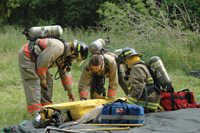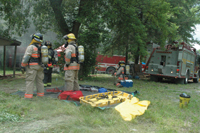
Features
Structural
Training
Trainer’s Corner: February 2011
This column is dedicated to the greatest resource in the Canadian fire services – you, the men and women who so faithfully train our firefighters.
February 8, 2011
By Ed Brouwer
This column is dedicated to the greatest resource in the Canadian fire services – you, the men and women who so faithfully train our firefighters. The list of skills that should be taught at the basic firefighter level can seem overwhelming. However, one skill set in particular stands out: firefighter rescue.
The rescue of a downed firefighter may have to be handled by any firefighter on scene. Let’s face it – most departments across Canada do not have the manpower for a dedicated rescue squad. So, all firefighters (regardless of their rank, responsibilities or experience) must be ready to step up to the task.
Here are the applicable standards in the rescue of a downed firefighter:
■ NFPA 1500: Standard for Firefighter Safety and Health
6.5.1: The fire department shall provide personnel for the rescue of members operating at emergency incidents if the need arises.
6.5.2: The rapid intervention crew shall consist of at least two members and shall be available for rescue of a member or a team if the need arises. Rapid intervention crews shall be fully equipped with the appropriate protective clothing, protective equipment, SCBA, and any specialized rescue equipment that might be needed given the specifics of the operation underway.
■ WCB 31.23 – Entry into buildings
- When a self-contained breathing apparatus must be used to enter a building, or a similarly enclosed location, a team of at least two firefighters must make the entry.
- Effective voice communications must be maintained between firefighters inside and outside the enclosed location. During the initial attack stages of an incident, at least one firefighter must remain outside.
- A suitably equipped rescue team of at least two firefighters must be established in the scene before sending in a second entry team and not more than 10 minutes after the initial attack.
- The rescue team required by subsection (4) must not engage in any duties that limit their ability to make a prompt response to rescue an endangered firefighter while interior structural firefighting is being conducted.
 |
|
| All firefighters should train on rapid intervention, as these firefighters did during a livae burn exercise at Six Nations, Ont., last summer. |
|
 |
|
| During RIT practice, be sure crew carry a complete breathing apparatus (including harness and face piece). A downed firefighter may have damaged his regulator or face piece. Photos by Laura King. |
In order to comply with NFPA 1500 and WCB 31.23, I suggest complete hands-on training to these standards, including the donning of full turnout gear and SCBA, more than just once a year. Try to incorporate as many obstacles as possible that may be found in an actual situation. Please do not limit your rescue to residential scenarios.
We must push for continued advancements in self-rescue and saving-our-own training levels. I often conclude my column with the statement, “Train like their lives depend on it, because they do.” In other words, we dare not train to the minimum (just enough to deflect or minimize lawsuits).
I have thought of approaching the good people at MythBusters (the popular Discovery Channel program that uses science to test the validity of rumours and myths) to once and for all bust the fatal RIT myths that we have embraced. These myths include the notion that a rapid intervention crew can get a firefighter out using one bottle of air and the belief that a firefighter in trouble will want to be rescued.
Yes, you read that correctly. It’s sad, but true. Just as someone drowning may become combatant and fight off a rescuer, there have been situations in which a firefighters in trouble will resist help. A possible cause of this may be the firefighter’s pride; a firefighter may resist even calling for help for fear of looking weak. This is mainly the fault of poor training and our portrayal of firefighters as superheroes – “first ones in, last ones out.”
However, carbon monoxide is responsible for a large percentage of accidental poisonings and deaths around the world every year, and firefighters are susceptible to carbon monoxide poisoning on the job. Firefighters may show signs and symptoms of carbon monoxide poisoning (such as headache, dizziness, weakness and disorientation), and as such, can become victims of the fire. Here’s an example:
Novato, Calif., firefighter Steven Rucker may have been overcome with carbon monoxide when he died fighting the Cedar wildland fire in Wynola, Calif., on Oct. 29, 2003.
The report from the National Institute of Occupational Safety and Health concluded that “hypoxia,” a reduced amount of oxygen in the blood and tissues, explained why Rucker appeared disoriented and confused and actually started walking toward flames when ordered by his captain to retreat to the safety of a house minutes before his death.
“While (the hypoxia) findings can explain (Rucker’s) confused behavior, it is unclear why his captain and other crew members, working under similar conditions, did not experience symptoms or signs of carbon monoxide poisoning,” the federal report says.
Here are some facts regarding rapid intervention that we at Canwest have noted from our Saving Our Own hands-on training sessions.
First and foremost, rapid intervention is seldom, if ever, rapid. It takes about four minutes for rapid intervention crews to enter after mayday.
- A 3000-psi bottle gives you 16.5 to 18.5 minutes.
- It takes about six minutes to find a downed firefighter.
- It takes about 25 minutes to get two firefighters out.
- It could take 12 firefighters to rescue one downed firefighter.
- One out of five rescuers will get into trouble.
The following are the top 12 reasons why firefighters get into trouble on the fire ground. Unfortunately, these situations do not often end well.
- tunnel vision
- inadequate survival training
- inexperienced officers
- inadequate understanding of fire behaviour
- failure to recognize deteriorating conditions
- freelancing
- inadequate communication skills
- failure to control doors
- opening doors, walls, ceiling or roof without a charged hose line
- failure to maintain an escape route
- ventilating at wrong location or time
- inadequate understanding of building construction
The interesting thing about this list is that every one of these reasons could easily be addressed through proactive training. If these are the main reasons firefighters are being killed, is it not reasonable to think we should address these areas through our training programs? Perhaps you should consider using these topics as a 12-week training schedule.
I urge you to remember that there is no such thing as a “routine” fire. There is the ever-present danger of the unexpected. If there’s a natural place for Murphy’s Law to exist, it’s the fire ground. Some unexpected events include flashover, backdraft, rapid fire increase, explosion, collapse and cardiac emergency. As much as these are unexpected events we can still prepare for them by proactively preparing our members.
The rescue of a downed firefighter may be necessary due to entrapment, SCBA malfunction, injury or medical emergency, or simply because the firefighter got lost or became disoriented. No matter the reason, there are really only two kinds of victims: those who are out of air; and those who will soon be out of air. With that in mind, when you practise RIT, be sure your rapid intervention crew carries in a complete breathing apparatus (including harness and face piece). The downed firefighter may have damaged his regulator or face piece. What you do consistently at practice will eventually be demonstrated on the fire ground.
The fire service is big on acronyms and one that comes to mind now is RC COLAS: Radio Communications and staying, Calm, Oriented, Low, Aware of Surroundings. The following is a brief outline of RC COLAS:
Radio communications: It is difficult for firefighters working inside a burning building to make tactical decisions without the input of other firefighters reporting conditions from outside. From a survival point of view, a radio may well be the one piece of equipment that makes the difference for the trapped or disoriented firefighter.
Stay calm: When confronted with danger, humans react by instinct. Our brains release chemicals (such as adrenalin) into our bodies and we go into fight-or-flight mode. I believe our basic instincts can be enhanced or empowered by repetitive training. As an example, firefighters who have repeatedly practised following a hose line out of a building are less likely to panic should they become disoriented: the higher the level of confidence, the lower the likelihood of panic should something go sideways. Lastly, but not least, it is vitally important that this confidence comes from the top down. Calm and confident leadership is absolutely crucial.
Stay oriented: A high percentage of firefighters killed inside structural fires simply got lost. Good, clear communication between the entry team and the incident commander is paramount. The information coming to the incident commander from the firefighters inside should enable the incident commander to map the progress of the firefighters as they move through the structure.
Stay low: All firefighters should know that the most severe heat and smoke conditions exist at the highest levels within a burning room. A firefighter who is suddenly exposed to high heat will have only a few seconds to think and act to safely escape the situation.
Stay aware of your surroundings: Many who are hurt or killed at interior structural fire operations were never aware of the dangerous conditions they were in until it was too late. It is absolutely imperative that firefighters know what is going on around them.
Observations of smoke colour, density and speed, coupled with the firefighter’s understanding of basic fire behaviour, can be lifesavers. Monitoring the area around you and listening to the reports of the conditions outside your particular room can give you those few extra seconds to retreat to an area of safety.
Even in mop-up or overhaul, expect the unexpected.
In a firefighter’s world, survival is the only benchmark of success. Until next time, stay safe, and train like their lives depend on it, because they do.
Ed Brouwer is the chief instructor for Canwest Fire in Osoyoos, B.C., and Greenwood Fire and Rescue. The 21-year veteran of the fire service is also a fire warden with the B.C. Ministry of Forests, a Wildland Urban Interface fire suppression instructor/evaluator and a fire-service chaplain. Contact Ed at ed@thefire.ca
Print this page